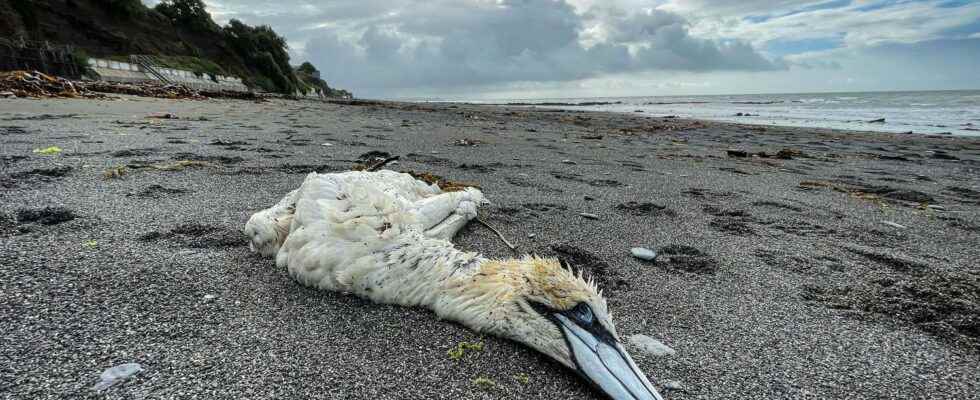This researcher at the National Veterinary School of Toulouse answers questions from franceinfo, while the H5N1 epidemic is decimating wild birds and even contaminating mammals.
The avian flu epidemic continues to wreak havoc among wild and domestic birds around the world. But does the virus threaten humans? Recent contaminations of mammals have raised some concerns. In France, a cat died of it at the end of January. To take stock of the situation, franceinfo interviewed Jean-Luc Guérin, researcher at the National Veterinary School of Toulouse (Haute-Garonne) and specialist in this H5N1 flu.
Franceinfo: Where does avian flu come from?
Jean-Luc Guerin : The story of this H5N1 virus began about 25 years ago (in 1996) in Guangdong, China. There was then a sneaky circulation throughout the Asian zone, with the appearance of new properties, such as the ability to infect humans occasionally and to settle in wildlife. We initially thought that it only concerned farms, because it appears in areas where there are high breeding densities – not necessarily industrial – of ducks, chickens and interactions with wildlife.
From 2005, the viruses circulated in the migration corridors, with a first focus in France at the beginning of 2006. They continued to evolve, to diversify and to form “reassortants” – an English term which designates the equivalent of variants. In this genetic abundance, a clade – that is to say a category –, 2.3.4.4.B, is the one that has been causing us concern since 2016. Within this clade, a “reassortant” has appeared, with a capacity for very efficient multiplication in many wild and domestic birds.
Where is the epidemic?
The host spectrum expanded and the virus became endemic. Until now, there was a close link between the virus and the flow of migratory birds. Since last summer, there has been no interruption in cases, the virus has taken hold in avian populations for a long time. Massive mortality phenomena have been observed in colonies of birds, particularly sea birds, or on vultures in the south of France. There are also mortalities throughout the territory among seagulls and crows. When you zoom out, this is the case in Europe, the United States and South America. We are talking about a panzootic.
What are the links between this disease and poultry farming?
Today, the virus does not need farms to spread. The spread comes from wildlife. But that doesn’t mean there wasn’t a connection originally, in Asia. There has undoubtedly been a back and forth between domestic animals and wild animals, which has led to the appearance of more severe and more contagious forms of the virus. In Europe, I don’t think we can say that farms play a role in the dynamics of infection. I do not exonerate breeding on a global scale, but it is not the breeders of the Southwest who are responsible.
Several cases of contamination of mammals have been reported in recent months. What is the risk to human health?
We observed a certain number of contaminations of mammals during the predation of sick birds: foxes, minks, bears or a cat in France. However, there are very few cases of mammal-to-mammal contamination. There was an episode in Spain in a mink farm, but we are not surprised: it is a species particularly receptive to the virus. There have also been cases in seals in Russia. Finally, there have been very rare human cases, difficult to document, and benign. [voir ce rapport de l’Autorité européenne de sécurité des aliments, en anglais]
These are now anecdotal cases, which are nevertheless the subject of very precise monitoring. The phenomenon is taken seriously by the veterinary community, but there is no indication that the virus has changed radically and that it would pose a very significant risk to humans.
However, there are so many contaminations in wildlife that, mathematically, a very unlikely phenomenon is more likely to occur. The more this virus spreads, the more birds there are that replicate it and the more you have the risk that there will be one that generates a new, more pathogenic variant. But for the moment, we are not there, we are far from having viruses adapted to humans.
“Viruses that are as effective in birds are not made to be as effective in humans.”
Jean Luc Guerinat franceinfo
Wildlife is very hard hit. What are the risks for biodiversity, which is already under threat?
It’s a real subject. Bird populations are very severely affected. There is a diversification of the species affected and not really any species that resist. Vultures in France are completely new. Normally, we should arrive at collective immunity, these mortalities should not last, if indeed there are no new viral forms. But we must remain very humble, there may be mortalities that we do not see on smaller and more solitary birds.
Nearly 50 million poultry have been slaughtered in Europe. What are the risks for French farms?
The spread of the virus has completely escaped the logic of infection of migratory birds. Until the winter of 2022, we had a postulate, with a risk period during the downward migration and risk zones. This made it possible to better calibrate the protection of farms in space and time. This pattern no longer holds true. We have possible contamination in summer and in low-risk areas.
“No poultry farm can feel safe from the introduction of the virus.”
Jean Luc Guerinat franceinfo
The Ministry of Agriculture has repeatedly mentioned the imminent arrival of a vaccine. Where we are ?
A first series of trials was conducted in duck farms, a priority in France for the role of the species in the spread of the virus. These trials are being analyzed and, in parallel, there is work being done to put in place a real action plan to be able to implement vaccination from September 2023.
